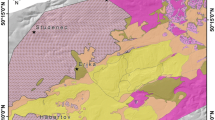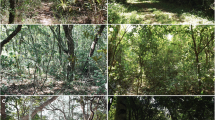Summary
A method for determining the buffering capacity (B.C.) of foliage extracts was standardized and evaluated. Sources of variations (biological, field and laboratory) were identified. These variations were reflected in inter-specific differences, seasonal fluctuations, age of the foliage and duration and the conditions of storage of the extracts. Procedures have been recommended to eliminate or minimize sources of variations (other than inherent specific) by standardizing the field sampling, laboratory processing and methods, and calculations of the buffering capacity. Plants such as lichens, known to be sensitive to air pollutants, had very low B.C. whereas species of intermediate sensitivity such as balsam fir had higher B.C. The B.C. being inherited and significantly different among species, has potential for its use in indexing the relative sensitivity of species to air pollutants especially in areas where large numbers of species are to be compared.
Similar content being viewed by others
References
Grill D and Härtel O 1972 Zellphysiologische und Biochemische Untersuchungen an SO2-begasten Fichtennadeln. Mitt. Forstl. Bundes-Versüchsanst. Wien 97, 367–384.
Ryan D F 1979 Nutrient resorption from senescing leaves: A mechanism of biochemical cycling in a northern hardwood forest ecosystem. Yale University, Ph D. thesis, 1979. University Microfilm International, Ann Arbor, U.S.A.
Rypácek V 1939 Die pH-Regulation des Mediums als Vitalitätsindikator der Pflanzengewebe. Stud. Bot. Cech. 2, 6–22.
Rypácek V 1940 Studien über die pH-Regulation durch Pflanzengewebe. Stud. Bot. Cech. 3, 81–129.
Scholz F 1974 Biochemische Untersuchungen zur Resistenz von Waldbäumen gegen Fluor-Immissionen.In Tagungsbericht der IX. Internationalen Tagung über Luftveruntreinigung in der Forstwirtschaft, Mariánské Lázne CSSR 1974. Prag: Min. Forst-Wasserwirtsch. CSSR 1975, pp 33–54.
Scholz F and Knabe W 1976 Investigations on buffering capacity in spruce clones of different resistance to air pollution. XVI IUFRO World Congress, Oslo, 1976. Section 2.09.04, 10 p.
Scholz F and Reck S 1977 Effects of acids on forest trees as measured by titrationin vitro, inheritance of buffering capacity inPicea abies. Water Air Soil Pollut. 8, 41–45.
Scholz F and Stephan B R 1974 Physiologische Untersuchungen über die unterschiedliche Resistenz vonPinus sylvestris gegenLophodermium pinastri. 1. Die Pufferkapazität in Nadeln. Eur. J. For. Path. 4, 118–126.
Sidhu S S 1979 LRTAP: Susceptibility of terrestrial systems in the Atlantic Provinces. Proc. Workshop. Long Range Transport of Air Pollutants and its impact on the Atlantic Region. Atmos. Environ. Serv., Bedford, Nova Scotia, Canada, pp 47–52.
Author information
Authors and Affiliations
Rights and permissions
About this article
Cite this article
Sidhu, S.S., Zakrevsky, J.G. A standardized method for determining buffering capacity of plant foliage. Plant Soil 66, 173–179 (1982). https://doi.org/10.1007/BF02183976
Received:
Revised:
Issue Date:
DOI: https://doi.org/10.1007/BF02183976




